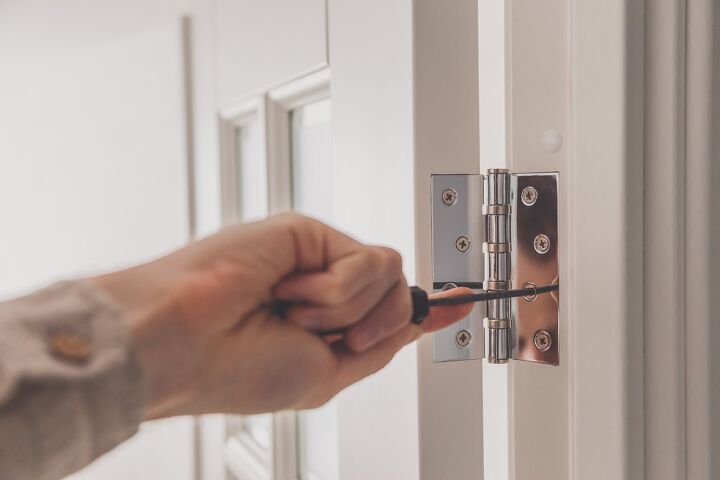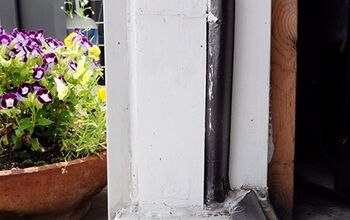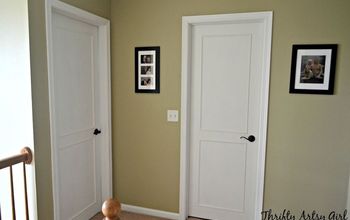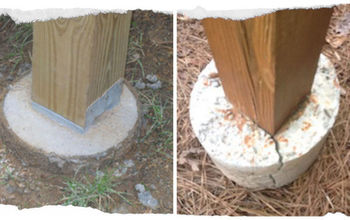How to Fix a Sagging Door That Won't Shut Properly

By Sharon Brandwein
A sagging door, or a door that tilts downward, is something that most homeowners will come across at one point or another. And it may be a problem that you’ve come to live with for long enough—but by not fixing a sagging door, gravity will only keep it moving downward, eventually impeding on the door's ability to fit correctly in its frame and shut properly.
There are a few reasons that doors eventually sag, which include loose door hinges or the door swelling from moisture and humidity. The good news is that these issues are fixable (to a point) without the need to call in reinforcements. In this guide, we'll help you figure out why your door might be sagging, and then we’ll show you how to fix a sagging door using multiple methods.
Photo via Handan & Greg @ The Navage Patch
Reasons Your Door Is Sagging
Doors are supposed to sit about an eighth of an inch above the floor and fit snugly in their frames without sticking. If your door isn’t behaving like this, it could be for one of three reasons:
Loose Hinges
Loose hinges are one of the most common reasons for sagging doors. From opening and closing day in and day out, door hinges may become loose from simple overuse. More often than not, the top hinge is the issue, but when checking the hinges, be sure to check the middle and bottom hinges just for good measure.
Moisture in the Wood
Quite often, moisture may collect in the door, causing it to swell and sag. This is especially common for doors that are close to heat sources, are in areas of poor ventilation, or in humid climates.
Settling or Foundation Issues
Houses settle over time—that’s a given—but in some extreme cases, that settling could lead to issues in the house. Sagging doors is one of them. It’s worth noting, though, that if your door is sagging as a result of settling, you may not be able to fix it with one of the methods listed below. If it’s a structural issue, you’ll probably need to call in a professional.
Photo via Shutterstock
How to Fix a Sagging Door by Tightening Hinges
Loose hinges are a common problem, and they can cause your doors to sag. If that’s the case, you will need to level the sagging door; here’s how. We’ll also tell you how to fix a stripped screw hole if you run into one.
Tool and Materials Needed:
- Screwdriver
- 3-inch screws
- Electric drill
- Toothpicks
- Wood glue
- Scissors
Step 1: Tighten Screws
Examine all door hinges and look for any loose or missing screws. Tighten loose screws and replace any that are missing. When tightening the screws, be sure to lift or raise the sagging door and support some of its weight while doing so. If the screws tighten and your hinges look like they’re back on track, then you can stop here. If the screws don’t tighten, the holes may be stripped. In that case, move on to step two.
Step 2: Replace with Longer Screw
If the screws spin and the hinge shows no signs of tightening, the screw holes may be stripped. You can try replacing the original screw with a longer screw to tighten the hinge (three inches would be fine). A longer screw just gets deeper into the door jamb for a better bite.
Step 3: Fill in Hole
Alternatively, you can tighten the screw hole. Start by removing the screw. Coat a few wooden toothpicks with wood glue and insert them into the screw hole. Then, snap or cut off the portion of the toothpicks that extend out of the screw hole. Be sure to make your cut flush with the door or the door jamb. Replace the hinge and screw it back into the hole.
How to Fix a Sagging Door with Shims
If tightening the hinge and addressing the stripped screw doesn’t work, you may have to move on to the next step—shimming the door. When shimming the door, you’re essentially placing something behind the hinge (not traditional wooden shims, but thick paper in this case) to tighten the space and give the hinge a better grip.
Tool and Materials Needed:
- Screwdriver
- Thick piece of paper (cardboard from a cereal box is great for this)
Step 1: Examine Door
Examine the door to determine which hinge you need to shim. If the door is sagging it would likely be the top hinge.
Step 2: Remove Hinge
Use a screwdriver to remove the hinge.
Step 3: Replace Hinge
Place a thick piece of paper between the hinge and the jamb. Replace the hinge.
How to Fix a Sagging Door by Drawing the Jamb In
If your door is sagging due to swelling or settling and neither of the previous two methods fixes the problem, you can try drawing the jamb in.
This has the same effect as tightening the hinges, only this time you’re working on the latch side of the door as opposed to the hinge side. While it may sound complicated, this method is really just driving a long screw into the jamb to compress it into the door frame, ultimately creating more room between the jamb and the door.
Tool and Materials Needed:
- Electric drill
- Three-inch screw
Step 1: Examine Door
Identify where the door looks tight against the jamb. That’s where you’ll drive the screw in.
Step 2: Drive Screw
Draw the jamb into the door frame by driving a three-inch screw into the jamb.
How to Fix a Sagging Door by Sanding
If loose hinges and wonky door jambs are not the culprits, then it’s possible that your door has swelled. Doors tend to do this as a result of high humidity. In that case, you can move on to the next possible fix—sanding or planing the door. This just means that you’re removing wood from the edge of the door. To do this right, you will have to scribe the door, so you know how much to sand or plane off.
This method is more involved and requires a bit more know-how, but it’s probably the last thing homeowners can try before sounding the alarm and calling for professional help.
Tool and Materials Needed:
- Carpenter’s compass
- Pencil or masking tape
- Standard screwdriver
- Slotted screwdriver
- Hammer
- Coarse sandpaper
- Hand planer or belt sander
- 120-grit sandpaper
- Paint and painting tools
Step 1: Mark the Door
Using a carpenter’s compass, mark the door at a spot that’s ⅛-inch from the edge of the door facing the jamb.
Tape Tip
Step 2: Remove Pins
Once you’ve identified where you’ll be sanding, remove the door's hook pins and move the door to an open area where you can place it on a level surface to continue working.
Removing Hook Pins
Step 3: Sand or Plane Edge
Sand or plane the edge you marked. For this step, you can use a hand planer. If you have a belt sander, you can use that too. Be sure to work slowly when you're sanding your door; you don't want to be overzealous and end up with a whole other problem because you sanded off too much.
Step 4: Smooth Wood
Once you’ve sanded off the portion of the door you marked for removal, you can smooth out the wood using 120-grit sandpaper.
Step 5: Repaint
After smoothing the edges, you can repaint said edge and replace the door.
When to Call a Professional
All of the fixes mentioned above are things that homeowners and strong DIYers can do themselves. However, if none of these methods work, that could be an indication of a bigger issue such as settling or a problem with your foundation.
In some cases, the next step would be to repair the door frame itself. Repairing a door frame often includes working with drywall, and if it's something you're not familiar with, you could end up making the problem much worse.
Long story short, if none of the methods discussed in this guide helped you fix a sagging door, it may be time to call a professional.
Do you have any more tips for fixing a sagging door? Tell us in the comments!

























Frequently asked questions
Have a question about this project?